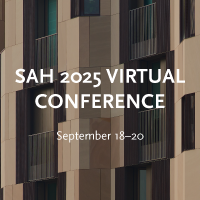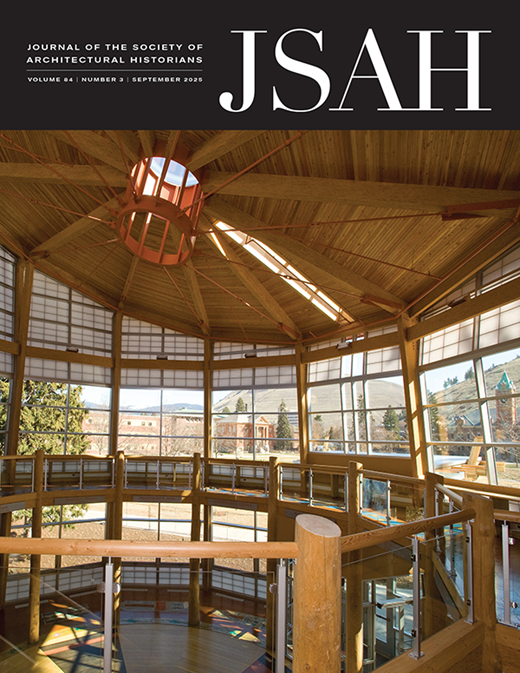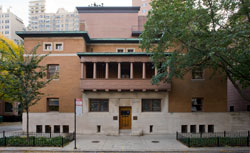-
Membership
Membership
Anyone with an interest in the history of the built environment is welcome to join the Society of Architectural Historians -
Conferences
Conferences
SAH Annual International Conferences bring members together for scholarly exchange and networking -
Publications
Publications
Through print and digital publications, SAH documents the history of the built environment and disseminates scholarship -
Programs
Programs
SAH promotes meaningful engagement with the history of the built environment through its programs -
Jobs & Opportunities
Jobs & Opportunities
SAH provides resources, fellowships, and grants to help further your career and professional life -
Support
Support
We invite you to support the educational mission of SAH by making a gift, becoming a member, or volunteering -
About
About
SAH promotes the study, interpretation, and conservation of the built environment worldwide for the benefit of all
Membership grants you access to exclusive resources and programs and provides support for new research and programs. Compare benefits across all our membership levels and choose the membership level that works for you.
Every Member Receives
- A yearlong subscription to the Journal of the Society of Architectural Historians (JSAH). Choose from digital access only or a combined print and digital subscription.
- On-demand access to the complete JSAH Archive (1941–present)
- Member rates for registration to SAH’s Annual International Conference
- AIA CES credits earned through conferences and study tours
- Eligibility to apply for SAH grants and fellowships
- Access to members-only lectures, virtual meetups, and more
- Connection to peers through 10 topic-focused SAH Affiliate Groups
- Access to more than 200,000 images of the built environment through the SAHARA database
- Access to SAH Commons online scholarly network
- Discount of 50% on JSTOR access with JPASS
- Eligibility to serve on the SAH Board or committees
- Subscription to the SAH Newsletter and Opportunities Weekly Roundup
Membership Levels
SAH Member
Our most popular membership tier offers optimized pricing to help everyone participate affordably in our community. Emerging scholars can apply for a one-year membership grant that helps bridge the gap between the Society's subsidized student memberships and full-cost SAH memberships.
| Rate | Description | Price: Digital | Price: Digital + Print |
| Individual | 12-month benefits for one person | $168 | $178 |
| Joint | 12-month benefits for two people (domestic partners). Each person receives a unique member ID and their own login to the member portal. | $240 | $250 |
| Retired/Emeritus | Discounted individual membership for former professionals on a fixed income | $101 | $111 |
| Reduced | Discounted individual membership for people working independently or at an institution without full-time employment. This includes adjunct and contingent faculty unemployed workers. | $101 | $111 |
| Global (Available Oct 1, 2025) | Affordable membership rates for global scholars living and working in countries the World Bank classifies as “low income.” | Scholars with qualifying addresses may receive up to 75% off the Individual Digital rate. Learn more. | |
| Student | Discounted individual membership for students currently enrolled in an undergraduate or graduate program in architectural history or related disciplines. | $62 | $72 |
| Professional Associate | Discounted individual memberships for groups of professionals working in the same museum, office, or firm. Ideal for architects, research or preservation groups, museum staff, and public design education. | $184 for first member + $106 for each additional member at the same institution | |
Upper-Level Member
Show your support for SAH’s mission by including a tax-deductible donation along with your Individual or Joint print + digital membership. Upper-level members receive all the benefits of a regular membership plus:
- Discount on registration for SAH Annual Conference, rates given below.
- Acknowledgement in four quarterly issues of JSAH, the annual report, and quarterly donor reports
- Membership to Frank Lloyd Wright National Reciprocal Sites Program, with which our headquarters, the Charnley-Persky House is affiliated.
- Early registration access for SAH Study and Excursion tours
| Tier | Donation | Price with Individual Membership | Price with Joint Membership | Discount on Annual Conference Registration |
| Cornerstone | $150 | $328 | $400 | 5% |
| Pillar | $350 | $528 | $600 | 7% |
| Keystone | $500 | $678 | $750 | 8% |
Life and Benefactor Member
Show your long-term commitment to SAH by becoming a Life member. Life members’ dues provide unrestricted funds to support the Society’s mission and continued opportunities for all members. Lock in your price and enjoy the most comprehensive suite of member benefits without the need to renew each year.
Life members receive these additional benefits:
- Acknowledgement in JSAH, annual report, and quarterly donor reports
- Membership to Frank Lloyd Wright National Reciprocal Sites Program, with which our headquarters, the Charnley-Persky House is affiliated.
- Early registration access for SAH Study and Excursion tours
- Specialty membership card
- Free tour of SAH's historic headquarters at the Charnley-Persky House in Chicago, IL
- One complimentary walking tour during SAH Annual Conference, reserved in advance, on a space-available basis.
- Free copy of an SAH Buildings of the United States book of your choice
Current Life Members can enhance their commitment to SAH by becoming a Benefactor through a $5,000 tax-deductible donation.
| Tier | Price | Donation Total |
| Life | $5,000 (one payment or four annual payments of $1,250) | None * |
| Benefactor | $10,000 | $5,000 |
* Life memberships are amortized over a period of 20 years and pay for annual benefits. There is no tax-deductible portion associated with Life membership.
President's Circle
SAH is immensely grateful to the many Life and Benefactor Members who continue to support the Society financially year after year. President’s Circle status recognizes the ongoing commitment these members show.
President’s Circle status is an annual distinction given to all Life and Benefactor members who make gifts to the Society of Architectural Historians totaling $1,000 or more during a given 12-month period. The status is applied to a donor as soon as they have achieved $1,000 in gifts within a single calendar year. The status is valid for 12 months from that date, and the date shall serve as an anniversary by which to renew their President's Circle status with one or more gifts totaling $1,000.
President's Circle members receive special benefits as thanks for their support:
- 10% discount on member-rate conference registration
- Recognition from the podium at SAH Celebrates annual gala
Limited-Access Affiliate
Affiliate Access permits one person to participate in the activities of one or more SAH Affiliate Groups and the SAH Commons online scholarly network, without access to any other SAH benefits such as JSAH or Membership registration rates for conferences or events. It is not considered an SAH Membership. Price is $25 per year.
Institutional Subscription
Institutional membership provides a subscription to JSAH and/or JSAH Online for communities of readers at public and academic libraries, museums, schools of architecture, architectural history departments, and other large institutions. Institutional subscribers receive the SAH Newsletter, qualify for discounted Career Center job ads, and member-rate registration for two library staff attending the SAH Annual International Conference.
The University of California Press handles institutional subscriptions on SAH's behalf. Visit the UC Press website to join or renew your Institutional subscription.
| Subscription Type | Price per Year | Additional Benefits |
|---|---|---|
| Digital Only | $693 | |
| Print + Digital - Domestic | $781 | |
| Print + Digital - International | $807 | |
| Sustaining | $881 |
|
Affiliate Groups
SAH Affiliate Groups are comprised of SAH members who share a common, narrowly defined interest, scholarly or otherwise. Participation in Affiliate Group activities is a benefit of SAH membership.
SAH Chapters
SAH has chapters located across the United States. Chapters are independently run organizations that are affiliated with SAH. SAH members can join chapters in their region.
Member Stories
Member Stories: Zixuan Zheng
Jun 24, 2025
by
SAH News
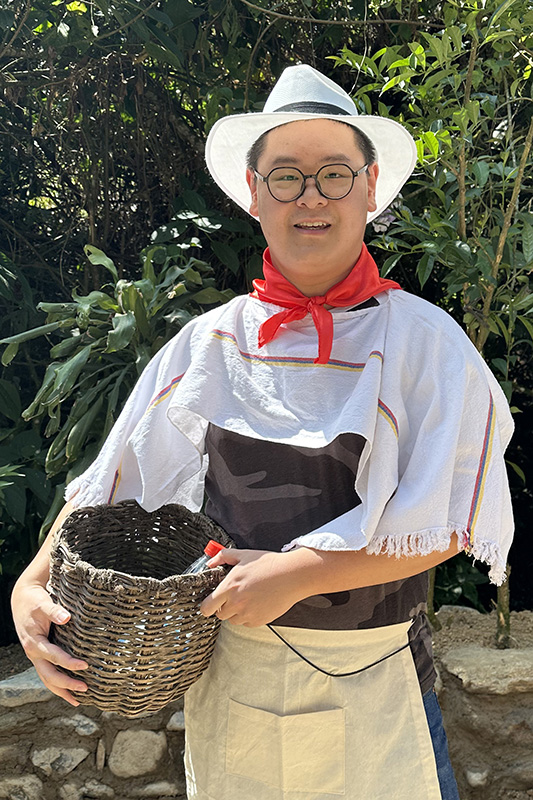
To begin, tell us a little about your background and and what you are working on now.
I am a first-year Ph.D. student at Illinois Institute of Technology (IIT). I obtained a Master of Architecture degree in May 2022 at the University of Southern California (USC) and a Bachelor of Architecture degree in June 2019 at the Zhejiang University of Science and Technology (ZUST).
My research currently focuses on urban regeneration and adaptive reuse projects, examining the trajectory of urban transportation and public space shift and the impact of urban morphology change. I am also in the multidisciplinary study with Fair Housing Laws, Urban Design, and Urban Landscape.
The precedents of my case study are the city of Chicago (U.S.) and the city of Hangzhou (China), as I have an international background, and I want to fully explore the differences between these two cities. My research is focusing on two sections: transportation changes and urban public space regeneration.
For the first section, the freeway system construction hugely changes the urban morphology of Chicago, as when the railway system formed the structure of the city. As we may have noticed, the freeway system caused more traffic jams and community separation due to its failed planning and arbitrary top-down urban renewal projects. It is interesting to map the city morphology of the current and past, and utilize the statistics from the census- population, crime rate, housing price, GDP, etc., to evaluate the failure of the mega infrastructure in Chicago.
Meanwhile Hangzhou, a famous tourist city in China, developed a completely different system from Chicago. The city chose to use a giant loop to connect the intercity freeway system and built regular ground transportation to connect the core area of the city. The good side of this pattern is that it separates the traffic flow more evenly, but the shortcoming is that it takes more time to commute from the suburbs to the city, and the connecting section between the freeway and the normal road always gets congested. As the city grows, Hangzhou builds more flyovers and express tunnels to connect the freeway more efficiently and smoothly, but from a morphology perspective, the city is getting shredded like Chicago.
Therefore, by applying the same methodology to map the city texture with the statistical data, I intend to bring the visual analysis to the table for future scholars to study.
The second section focuses on the urban regeneration/adaptive reuse projects in urban public space in both cities. In Hangzhou, I have chosen to examine Hanggang Park. It was once the Steel Plant of Hangzhou with severe pollution. But, as the city's economy grew, they shut down the plant for decades and left it abandoned. In recent years, with the national policy of revitalizing the public space in the old city, Hanggang Park was selected and fully redesigned as an urban green space that reused the old steel plant and most factory buildings inside. It integrates the philosophy of the traditional Chinese garden and arboretum design into the existing site. It turns into a new hub for citizens to hang out during the weekend, a community center, and a new tourist site. An aside: It was designed by Jiakun Liu, who won the Pritzker prize this year.
For a counterpart in Chicago, I may choose Trail 606, a disused elevated rail line turned into a park. I am still assessing its value for my research.
What's keeping you busy outside of work?
Traveling around the world, cooking, and photography.
I love to explore different cuisines in different countries when I am traveling. Mainly, I cook fusion food; It’s like absorbing the food I like when I was outside, and integrating it with my own style. I love hosting dinners for my friends.
In my photography, I focus mostly on architecture and scenery (nature) shooting.
Share a particular memory of when you first became aware of architecture, or when you knew you wanted to study its significance.
When I was in high school, I didn't realize that I wanted to become an architect, but I had a high interest in designing space and floor plan, so my high school teacher suggested me to select architecture when I went to the university. It turns out that I selected the correct major, and I get my high-level education, internship, and full-time working experience all in architecture design.
What interests you most about architectural history?
I am interested in the urban space and transportation development after WWII, both in developed and developing regions.
I always want to study architecture in the contemporary world. While I was taking the urbanism and landscape courses, I found myself particularly interested in mobility (freeway system, railway, and aviation) and urban public space/green space design and criticism. That’s why my PhD research will focus on these two topics, they look like individual trajectories, but they are highly integrated, which shapes the city development. So far, I am reading everything I can to get a clearer and holistic understanding of the transportation history of Chicago and Hangzhou.
Professional challenges are everywhere. What is your advice for facing them, and perhaps, overcoming them?
Start doing the work from the tiny bit, bite the pizza piece by piece. Don't be terrified by the overall scheme.
When and how did you first become involved in SAH?
I became a member of SAH in 2021 on the recommendation of Professor Marcos A. Potroli, when I was working with him as a Class Assistant. I told him that I want to conduct research in academia, and he suggested that I should join the SAH annual conference if I want to continue studying at the PhD level.
How has SAH enriched your experience in architectural history?
SAH enriched my experience by knowing different scholars, fellows, and friends in different trajectories. Besides the architectural history and history, I learned a lot from other disciplines, which somehow interact with a certain period in architectural history.
What advice would you give to your former self?
Follow your heart! This encourages me to pursue a PhD degree and engage in a teaching career, which I was vaguely thought about it 10 years ago.
This story is published as part of an ongoing series exploring the varying careers and experiences of SAH's diverse members. What's your story? Share it with us through our online questionnaire.
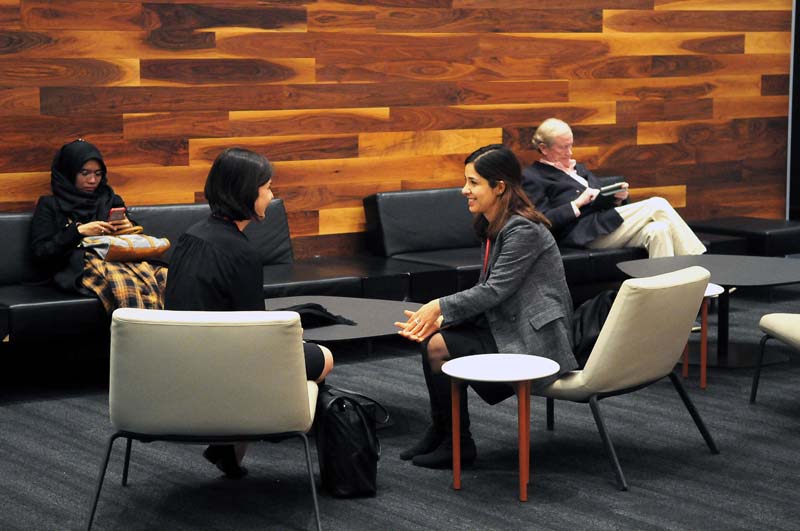
Membership Grants
Emerging scholars can apply for a one-year membership grant that helps bridge the gap between the Society's subsidized student memberships and full-cost SAH memberships.
